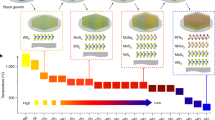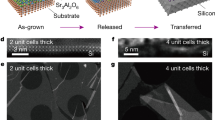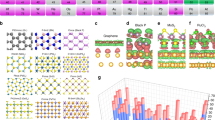Abstract
Mechanical cleavage of layered structures is the most effective method to obtain pristine two-dimensional (2D) sheet materials. However, this approach is restricted to materials in which interlayer interactions are dominated by weak van der Waals (vdW) forces. Here, we report a generic approach to mechanically exfoliate non-vdW structures to obtain a wide variety of 2D materials, including metals (Bi, Sb), semiconductors (SnO, V2O5, Bi2O2Se) and superconducting compounds (KV3Sb5). Our approach involves laterally sliding closely packed neighbouring layers to transform the structure from a stable to a metastable phase, weakening interlayer binding. Mechanical exfoliation of the metastable structures using the Scotch tape method yielded stable mono and few layers of the materials with exciting physical properties. For example, the bandgap for metals and semiconductors was modulated across a wide range depending on the number of layers (0 to 2.01 eV for Sb, 0.60 eV (infrared) to 3.65 eV (ultraviolet) for SnO). We also obtained few-layer KV3Sb5, which is a promising material for studying unconventional superconductivity. Our method for mechanically exfoliating non-vdW layered materials increases the availability of 2D materials for exploration of their physical characteristics and potential applications.

This is a preview of subscription content, access via your institution
Access options
Subscribe to this journal
Receive 12 digital issues and online access to articles
$119.00 per year
only $9.92 per issue
Buy this article
- Purchase on Springer Link
- Instant access to full article PDF
Prices may be subject to local taxes which are calculated during checkout





Similar content being viewed by others
Data availability
All data that support the findings of this study are available in the main article and Supplementary Information. Source data are provided with this paper.
References
Novoselov, K. S. et al. Electric field effect in atomically thin carbon films. Science 306, 666–669 (2004).
Tan, C. et al. Recent advances in ultrathin two-dimensional nanomaterials. Chem. Rev. 117, 6225–6331 (2017).
Butler, S. Z. et al. Progress, challenges, and opportunities in two dimensional materials beyond graphene. ACS Nano 7, 2898–2926 (2013).
Zhou, J. et al. A library of atomically thin metal chalcogenides. Nature 556, 355–361 (2018).
Stankovich, S. et al. Nature 442, 282–286 (2006).
Duan, X., Wang, C., Pan, A., Yu, R. & Duan, X. Two-dimensional transition metal dichalcogenides as atomically thin semiconductors: opportunities and challenges. Chem. Soc. Rev. 44, 8859–8876 (2015).
Huang, Y. et al. Universal mechanical exfoliation of large-area 2D crystals. Nat. Commun. 11, 2453 (2020).
Deng, Y. et al. Gate-tunable room-temperature ferromagnetism in two-dimensional Fe3GeTe2. Nature 563, 94–99 (2018).
Liu, F. et al. Disassembling 2D van der Waals crystals into macroscopic monolayers and reassembling into artificial lattices. Science 367, 903–906 (2020).
Novoselov, K. S. et al. Two-dimensional atomic crystals. Proc. Natl Acad. Sci. USA 102, 10451–10453 (2005).
Mak, K. F., Lee, C., Hone, J., Shan, J. & Heinz, T. F. Atomically thin MoS2: a new direct-gap semiconductor. Phys. Rev. Lett. 105, 136805 (2010).
Abhervé, A., Mañas-Valero, S., Clemente-León, M. & Coronado, E. Graphene related magnetic materials: micromechanical exfoliation of 2D layered magnets based on bimetallic anilate complexes with inserted [FeIII(acac2-trien)]+ and [FeIII(sal2-trien)]+ molecules. Chem. Sci. 6, 4665–4673 (2015).
Liu, H. et al. Phosphorene: an unexplored 2D semiconductor with a high hole mobility. ACS Nano 8, 4033–4041 (2014).
Li, L. et al. Black phosphorus field-effect transistors. Nat. Nanotechnol. 9, 372–377 (2014).
Nicolosi, V., Chhowalla, M., Kanatzidis, M. G., Strano, M. S. & Coleman, J. N. Liquid exfoliation of layered materials. Science 340, 1226419 (2013).
Zhang, X. & Xie, Y. Recent advances in free-standing two-dimensional crystals with atomic thickness: design, assembly and transfer strategies. Chem. Soc. Rev. 42, 8187–8199 (2013).
Miessler, G. L., Fischer, P. J. & Tarr, D. A. Inorganic Chemistry 2nd edn (Prentice Hall, 1999).
Zhou, W. & Umezawa, N. Band gap engineering of bulk and nanosheet SnO: an insight into the interlayer Sn–Sn lone pair interactions. Phys. Chem. Chem. Phys. 17, 17816 (2015).
Qu, C. et al. Origin of friction in superlubric graphite contacts. Phys. Rev. Lett. 125, 126102 (2020).
Song, Y. et al. Robust microscale superlubricity in graphite/hexagonal boron nitride layered heterojunctions. Nat. Mater. 17, 894–899 (2018).
Saji, K. J., Tian, K., Snure, M. & Tiwari, A. 2D tin monoxide—an unexplored p-type van der Waals semiconductor: material characteristics and field effect transistors. Adv. Electron. Mater. 2, 1500453 (2016).
Zhang, F., Zhu, J., Zhang, D., Schwingenschlögl, U. & Alshareef, H. N. Two-dimensional SnO anodes with a tunable number of atomic layers for sodium ion batteries. Nano Lett. 17, 1302–1311 (2017).
Li, B. et al. Van der Waals epitaxial growth of air-stable CrSe2 nanosheets with thickness-tunable magnetic order. Nat. Mater. 20, 818–825 (2021).
Lee, C. et al. Anomalous lattice vibrations of single and few-layer MoS2. ACS Nano 4, 2695–2700 (2010).
Ross, J. S. et al. Electrical control of neutral and charged excitons in a monolayer semiconductor. Nat. Commun. 4, 1474 (2013).
Xi, X. et al. Ising pairing in superconducting NbSe2 atomic layers. Nat. Phys. 12, 139–143 (2016).
Zhou, X. et al. Ultrathin 2D GeSe2 rhombic flakes with high anisotropy realized by van der Waals epitaxy. Adv. Funct. Mater. 27, 1703858 (2017).
Daeneke, T. et al. Wafer-scale synthesis of semiconducting SnO monolayers from interfacial oxide layers of metallic liquid tin. ACS Nano 11, 10974–10983 (2017).
Deng, B. et al. Efficient electrical control of thin-film black phosphorus bandgap. Nat. Commun. 8, 14474 (2017).
Cakir, D., Sahin, H. & Peeters, F. M. Tuning of the electronic and optical properties of single-layer black phosphorus by strain. Phys. Rev. B 90, 205421 (2014).
Liu, B. et al. Black arsenic-phosphorus: layered anisotropic infrared semiconductors with highly tunable compositions and properties. Adv. Mater. 27, 4423–4429 (2015).
Li, H. et al. Growth of alloy MoS2xSe2(1−x) nanosheets with fully tunable chemical compositions and optical properties. J. Am. Chem. Soc. 136, 3756–3759 (2014).
Shi, H., Pan, H., Zhang, Y. & Yakobson, B. I. Quasiparticle band structures and optical properties of strained monolayer MoS2 and WS2. Phys. Rev. B 87, 155304 (2013).
Li, H. et al. Activating and optimizing MoS2 basal planes for hydrogen evolution through the formation of strained sulphur vacancies. Nat. Mater. 15, 48–53 (2016).
Chaves, A. et al. Bandgap engineering of two-dimensional semiconductor materials. npj 2D Mater. Appl. 4, 29 (2020).
Aktürk, O. U., Özcelik, V. O. & Ciraci, S. Single-layer crystalline phases of antimony: antimonenes. Phys. Rev. B 91, 235446 (2015).
Ortiz, B. R. et al. New kagome prototype materials: discovery of KV3Sb5, RbV3Sb5, and CsV3Sb5. Phys. Rev. Mater. 3, 094407 (2019).
Neupert, T., Denner, M. M., Yin, J.-X., Thomale, R. & Hasan, M. Z. Charge order and superconductivity in kagome materials. Nat. Phys. 18, 137–143 (2022).
Niu, L. et al. Charge-density-wave-driven electronic nematicity in a kagome superconductor. Nature 604, 59–64 (2022).
Chen, H. et al. Roton pair density wave in a strong-coupling kagome superconductor. Nature 599, 222–228 (2021).
Song, B. Q. et al. Competing superconductivity and charge-density wave in kagome metal CsV3Sb5: evidence from their evolutions with sample thickness. Preprint at https://doi.org/10.48550/arxiv.2105.09248 (2021).
Song, Y. et al. Competition of superconductivity and charge density wave in selective oxidized CsV3Sb5 thin flakes. Phys. Rev. Lett. 127, 237001 (2021).
Oritiz, B. R. & Sarte, P. M. Superconductivity in the Z2 kagome metal KV3Sb5. Phys. Rev. Mater. 5, 034801 (2021).
Yang, S. et al. Giant, unconventional anomalous hall effect in the metallic frustrated magnet candidate, KV3Sb5. Sci. Adv. 6, eabb6003 (2020).
Jiang, Y. et al. Unconventional chiral charge order in kagome superconductor KV3Sb5. Nat. Mater. 20, 1353–1357 (2021).
Acknowledgements
We acknowledge financial support from the National Natural Science Foundation of China (grant no. 52173288). We thank H. Liu and Y. Shi at the Institute of Physics, Chinese Academy of Sciences for providing KV3Sb5 bulk crystals, Z. Zhang at the University of Science and Technology Beijing and Y. Qin at Xi’an Jiaotong University for constructive discussions. The funders had no role in study design, data collection and analysis, decision to publish or preparation of the manuscript.
Author information
Authors and Affiliations
Contributions
F.G. conceived and supervised the research. K.J., J.J. and L.D. performed experiments. W.G. and J.L. undertook theoretical calculations. P.L. assisted with experiments. B.L. collected experimental data of critical stress for sliding. All authors analysed data and F.G. organized the paper with input from all co-authors.
Corresponding author
Ethics declarations
Competing interests
The authors declare no competing interests.
Peer review
Peer review information
Nature Synthesis thanks the anonymous reviewers for their contribution to the peer review of this work. Primary Handling Editor: Peter Seavill, in collaboration with the Nature Synthesis team.
Additional information
Publisher’s note Springer Nature remains neutral with regard to jurisdictional claims in published maps and institutional affiliations.
Supplementary information
Supplementary Information
Experimental details and Supplementary Figs. 1–28.
Source data
Source Data Fig. 1
Statistical source data.
Source Data Fig. 2
Statistical source data.
Source Data Fig. 3
Statistical source data.
Source Data Fig. 4
Statistical source data.
Source Data Fig. 5
Statistical source data.
Rights and permissions
Springer Nature or its licensor holds exclusive rights to this article under a publishing agreement with the author(s) or other rightsholder(s); author self-archiving of the accepted manuscript version of this article is solely governed by the terms of such publishing agreement and applicable law.
About this article
Cite this article
Jiang, K., Ji, J., Gong, W. et al. Mechanical cleavage of non-van der Waals structures towards two-dimensional crystals. Nat. Synth 2, 58–66 (2023). https://doi.org/10.1038/s44160-022-00182-6
Received:
Accepted:
Published:
Issue Date:
DOI: https://doi.org/10.1038/s44160-022-00182-6
This article is cited by
-
2D quasi-layered material with domino structure
Nature Communications (2023)
-
A general strategy for synthesizing biomacromolecular ionogel membranes via solvent-induced self-assembly
Nature Synthesis (2023)



